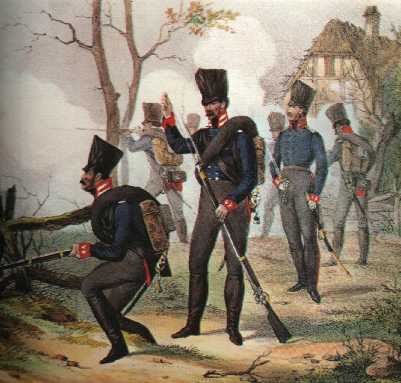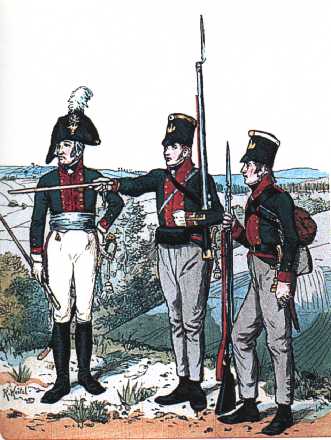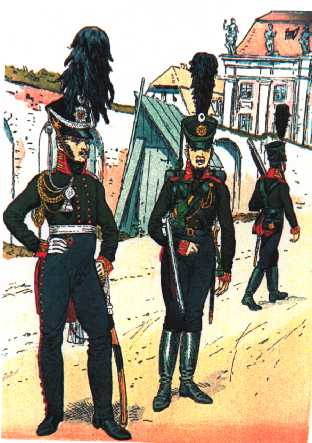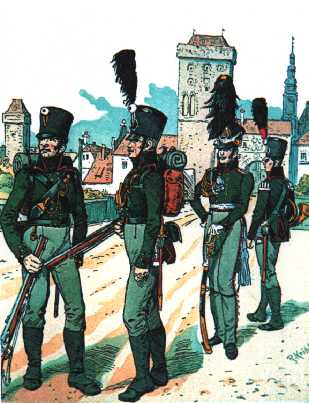
Prussian Light Infantry

Prussian Light Infantry (Fusiliers of the 1st Foot Guards) in action, 1813
Introduction
Prussian light infantry was divided into 3 basic types - Schuetzen, Jaeger and Fusiliers. The Schuetzen were handpicked men attached to every line infantry company. These men were potential NCOs. Jaegers were elite formations equivalent to the British Rifles. They were recruited from hunters (hence the name - Jaeger) and foresters and were thus skilled marksmen. Fusiliers were the normal light infantry of the Prussian army.
Organisation
Until 1808, Schuetzen sections of 10 men each were attached to each line infantry company. 40 Schuetzen were also attached to each Fusilier battalion. In 1809, the Silesian Schuetzen battalion was formed. In 1814, a battalion of Guard Schuetzen was formed.
There was 1 Jaeger Regiment of 10 companies totalling nearly 2,000 officers and men in 1806. In 1808, the Jaeger Regiment was reorganised into the Guard Jaeger battalion and the East Prussian Jaeger battalion - each of around 500 men.
In 1806, there were 24 Fusilier battalions organised into 8 brigades of 3 battalions each. Each battalion had 4 companies and had a strength of around 700 officers and men. With the reforms of 1808, the Fusilier brigades were disbanded and each line infantry regiment received a Fusilier battalion.
Uniforms
Fusiliers - 1806 uniform pictured below. Black shako with white (NCOs gold) band on top. Dark green coat with facing colours on collar, shoulder straps, lapels and cuffs. The facing colours of the Fusilier Brigades were as follows:
| Brigade | Battalions | Facings | Buttons |
| Magdeburg | 1, 2, 5 | carmine | yellow |
| Westphalian | 18, 19, 20 | carmine | white |
| 1st East Prussian | 3, 6, 11 | light green | yellow |
| 2nd East Prussian | 21, 23, 24 | light green | white |
| 1st Warsaw | 4, 8, 16 | light blue | yellow |
| 2nd Warsaw | 9, 12, 17 | light blue | white |
| Lower Silesia | 13, 14, 15 | black | yellow |
| Upper Silesia | 7, 10, 22 | black | white |
In 1808, 1 Fusilier battalion was incorporated into each line infantry regiment. Hence, the Fusiliers adopted the uniforms of the line infantry with the following distinctions - white cockade with black centre in place of shako badge, and black crossbelts and equipment strap instead of white. (See title illustration to get an impression of the 1808 Fusilier uniform.)

L-R: Fusilier Officer, NCO and private ca. 1806. Knoetel print.
Jaeger - In 1806, Jaeger uniform was a black bicorne with dark green feather plume. Coats were dark green with red collars and cuffs. The coat was closed to the waist with dark green lapels. Breeches were white with knee boots. (If you have a box of the old ESCI Prussian and Austrian Napoleonic Infantry, the painting example on the back of the box is that of a Prussian 1806 Jaeger.)
In 1808, the Foot Jaeger Regiment was reorganised into the East Prussian Jaeger battalion and the Guard Jaeger battalion. The uniform of the Guard Jaeger battalion is pictured below. Both battalions had similar uniforms - ie Black shako with tall black feather plume and green cords, dark green coat with red collar, cuffs and shoulder straps. The turnbacks were also piped red. Grey overalls with knee boots were worn on campaign. The plume was also not worn on campaign and the shako was covered with an oil skin. The Guard Jaegers had the following distinctions - yellow guard lace on collars and cuffs, star badge on shako front.

Guard Jaeger in 1808 uniform. L-R: Officer, private front view, private rear view. Knoetel print.
Schuetzen - The schuetzen sections of the line infantry regiments in 1806 wore basically the same uniform as their parent regiment. The Silesian Schuetzen Battalion was formed in 1809. It wore the uniform pictured below - ie black shako, dark green coat with black collar, shoulder straps and cuffs piped red. The turnbacks were dark green piped red.

Silesian Schuetzen Battalion ca.1809. L-R: private, private wearing plume, officer and hornist. Knoetel print.
All Knoetel prints reproduced courtesy of Uniformology.
Acknowledgement and Sources:
I wish to thank Peter Hofschr÷er for going through the above text. Any mistakes, of course, remain my own. As the above is only a brief introduction, the reader is directed to the following additional sources for more detail:
Peter Hofschr÷er and Bryan Fosten: Prussian Light Infantry (Osprey Men-at-Arms)
Philip Haythornthwaite: Uniforms of Waterloo
Liliane and Fred Funcken: Historische Uniformen
[an error occurred while processing this directive]